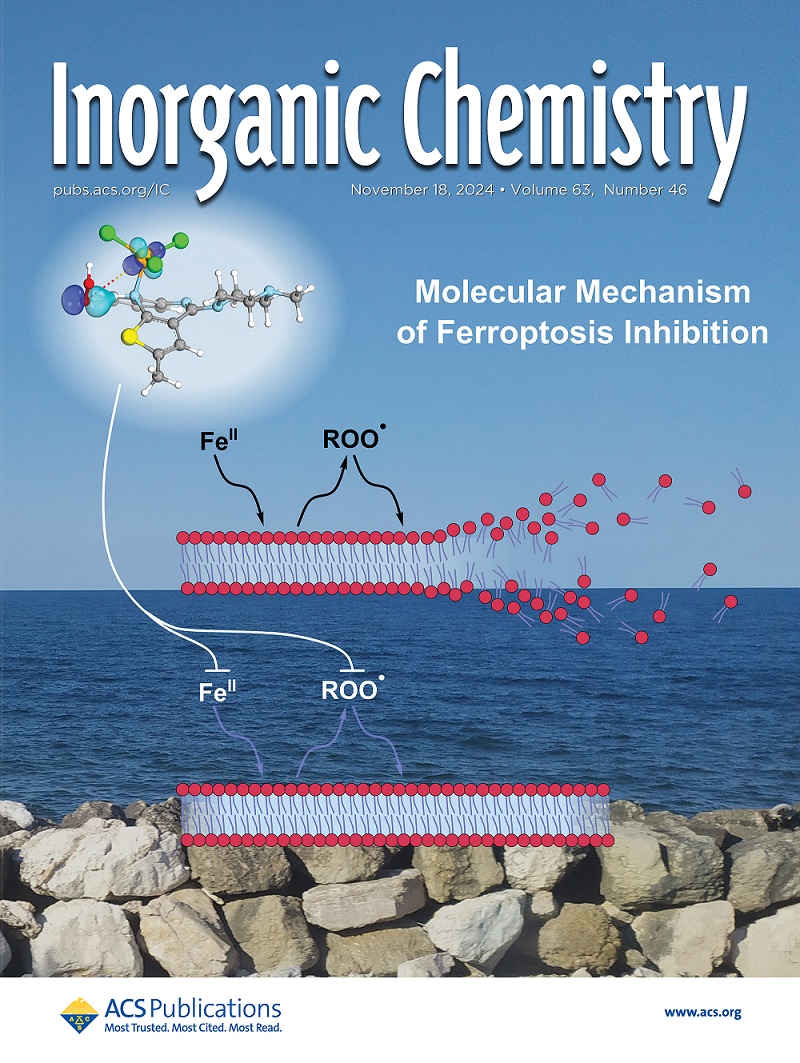锑基二维卤化物双钙钛矿的方向和温度依赖性质。
IF 4.3
2区 化学
Q1 CHEMISTRY, INORGANIC & NUCLEAR
引用次数: 0
摘要
二维(2D)有机-无机卤化物双钙钛矿因其结构多样性和化学可调性而受到广泛关注。本文报道了一种新的二维层状卤化物双钙钛矿材料(BrPA)4AgSbBr8 (BPAS),并将其性能与(BrPA)4AgInBr8 (BPAIn, PA─丙基铵)和先前报道的非中心对称Cl0.26Br3.74PA4AgSbBr8 (CPAS, CPA─氯丙基铵)进行了比较。BPAS和BPAIn在P2/c单斜空间群中结晶,由两层有机连接剂分离的一价和三价阳离子形成二维无机八面体。不像它们的三维对应物Cs2Ag(In/Sb)X6 (x -卤化物),八面体是扭曲的,降低了它们的对称性。这导致了材料的光隙变宽,也影响了材料的光致发光和导电性能。BPAS显示出轻微的间接带隙,但显示出由带到带,自由/束缚激子和自捕获激子态贡献的PL发射。STEs使这两种材料的发射范围更广。材料的二维性质显示出各向异性的传导特性,其中发现面内传导与面外传导不同。电荷转移电阻的值从GΩ(-73℃)降低到kΩ(202℃),这是由于热激活的载流子迁移率通过相关的跃迁机制存在。本文章由计算机程序翻译,如有差异,请以英文原文为准。
Direction and Temperature-Dependent Properties of an Antimony-Based Two-Dimensional Halide Double Perovskite.
Two-dimensional (2D) organic-inorganic halide double perovskites have attracted wide attention due to their structural diversity and chemical tunability. Herein, we report a new 2D layered halide double perovskite material, (BrPA)4AgSbBr8 (BPAS), and its properties are compared with (BrPA)4AgInBr8 (BPAIn, PA─propylammonium) and previously reported noncentrosymmetric Cl0.26Br3.74PA4AgSbBr8 (CPAS, CPA─chloropropylammonium). BPAS and BPAIn crystallize in the P2/c monoclinic space group with 2D layers of inorganic octahedra formed by monovalent and trivalent cations separated by two layers of organic linkers. Unlike their 3D counterparts, Cs2Ag(In/Sb)X6 (X-halide), the octahedra are distorted, reducing their symmetry. This led to the broadening of the optical gap in the present materials and also affected the photoluminescence (PL) and conduction properties. The BPAS shows a slight indirect band gap but shows PL emission with contributions from band-to-band, free/bound excitonic, and self-trapped excitonic states. The STEs enabled broader emission in these two materials. The 2D nature of the material shows anisotropic conduction properties where the in-plane conduction is found to be different from out-of-plane conduction. The value of charge transfer resistance decreases from GΩ (at -73 °C) to kΩ (at 202 °C) due to the presence of thermally activated carrier mobility through a correlated barrier hopping mechanism.
求助全文
通过发布文献求助,成功后即可免费获取论文全文。
去求助
来源期刊

Inorganic Chemistry
化学-无机化学与核化学
CiteScore
7.60
自引率
13.00%
发文量
1960
审稿时长
1.9 months
期刊介绍:
Inorganic Chemistry publishes fundamental studies in all phases of inorganic chemistry. Coverage includes experimental and theoretical reports on quantitative studies of structure and thermodynamics, kinetics, mechanisms of inorganic reactions, bioinorganic chemistry, and relevant aspects of organometallic chemistry, solid-state phenomena, and chemical bonding theory. Emphasis is placed on the synthesis, structure, thermodynamics, reactivity, spectroscopy, and bonding properties of significant new and known compounds.
 求助内容:
求助内容: 应助结果提醒方式:
应助结果提醒方式:


